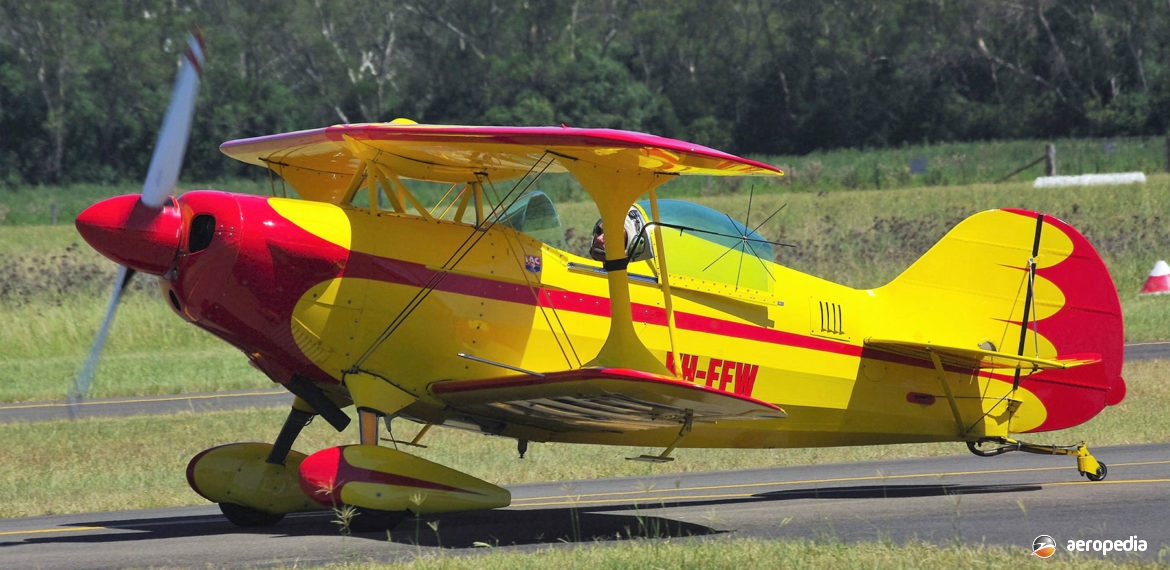Photograph:
Pitts S-1 VH-FFW (c/n 46) at Camden, NSW in January 2011 (David C Eyre)
Country of origin:
United States of America
Description:
Single-seat sporting biplane
Power Plant:
One 149 kw (200 hp) Lycoming AEIO-360-A1E four-cylinder horizontally-opposed air-cooled engine
Specifications:
- Wingspan [upper]: 5.28 m (17 ft 4 in)
- Length: 4.72 m (15 ft 6 in)
- Height: 1.91 m (6 ft 3 in)
- Wing area: 9.15 m² (98.5 sq ft)
- Max level speed: 298 km/h (185 mph)
- Max cruising speed at sea level: 282 km/h (175 mph)
- Stalling speed: 103 km/h (64 mph)
- Max rate of climb at sea level: 853 m/min (2,800 ft/min)
- Service ceiling: 6,795 m (22,300 ft)
- Range with max fuel at 55% power, with 30 mins reserve: 497 km (309 miles)
- Empty weight: 376 kg (830 lb)
- Loaded weight: 522 kg (1,150 lb)
- Max wing loading: 57.05 kg/m² (11.68 lb/sq ft)
- Max power loading: 3.50 kg/kw (5.75 lb/hp)
History:
The Pitts Special series of aircraft was designed by Curtiss Pitts, the well-known American designer, as a high-performance, light sporting biplane, the first example, known as the S-1 Special, flying in September 1944. Subsequently it was chosen by many of the western world’s finest aerobatic pilots as a competition aircraft, and has been flown by many teams in the World Aerobatic Championships, including the American and Australian teams. In more recent years it has succumbed to newer purpose-built designs, such as the Edge series from Germany, and the Sukhoi series from Russia. However, many pilots still consider the Pitts Special has no equal in this role.
The series was produced in two basic variants, a single-seater and a two-seater. The model S-1D was designed for the home constructor, with plans and some components being supplied. The S-1S was produced in the USA by Pitts as a complete aircraft, or in kit form, and had a 134 kw (180 hp) Lycoming IO-360 engine driving a fixed-pitch propeller. The S-2A, which was the two-seat version, was supplied as a complete aircraft. The S-1T had an up-rated 149 kw (200 hp) engine and a variable-pitch propeller, being introduced in 1981, having a constant-speed propeller as an option, and symmetrical wings. The S-1D and S-1E were homebuilt variants for which plans became available; and eventually the S-1S and S-1T also became available but in kit form.
The first Pitts S-1 in Australia was VH-DDS (c/n V26) registered on 29 May 1975. It was lost in an accident on 27 January 1985 at Lake Eppalock, VIC. It was recovered, rebuilt and re-registered in March 1987, the registration being changed in May 1992 to VH-JVP. In 1986 Australian pilots took their Pitts (VH-SIE and VH-IOO) to Gloucestershire in England for the World Aerobatic Championships.
For some years up to three have operated on joy-flights out of Bankstown, NSW, and the Sydney Aerobatic School has had one commercially registered. In 1985 Chris Sperou, the Australian Aerobatic Champion, in VH-CEX, an S-1S, set a new altitude record over Adelaide, SA by flying to 8,230 m (27,000 ft), taking an hour to ascend and 30 minutes to descend. An aerobatic team was set up in the 1980s with four Pitts called the Skydancers; and another team was known as the Brut 33 Skyblazers with two Pitts.
Some nine examples of the S-1 series appear on the New Zealand register and 22 on the Australian register. Some of these have been imported in their completed form from the factory, and some have been manufactured from kits. In recent times further variants have appeared, including the high-performance S1-11B Super Stinker, an example of which is VH-XPS (c/n PJU-002). This model has been available from Aviat Aircraft of Wyoming, USA, is capable of six vertical rolls and holding in a vertical hover, followed by a push-over to forward flight without loss of power or height. It has a three-blade variable-pitch propeller enabling a slower vertical descent than climb and has a roll rate in excess of 400 degrees per second.
The fuselage of the Pitts series was made up of welded steel-tube structure to which plywood formers and wooden stringers were fitted. The whole fuselage was fabric covered, except for the aluminium front panels. Both wings had solid spruce spars, to which were fitted wooden ribs, and each wing panel was internally and externally wire braced, and fabric covered. The wings were set at 6.75 degrees sweep-back at the quarter chord line. Frise-type ailerons were fitted to the lower wings. The main undercarriage was made up of welded steel-tube using rubber cord shock absorption. A 72.74 litre (16 Imp gal) fuel tank was located immediately aft of the firewall.

